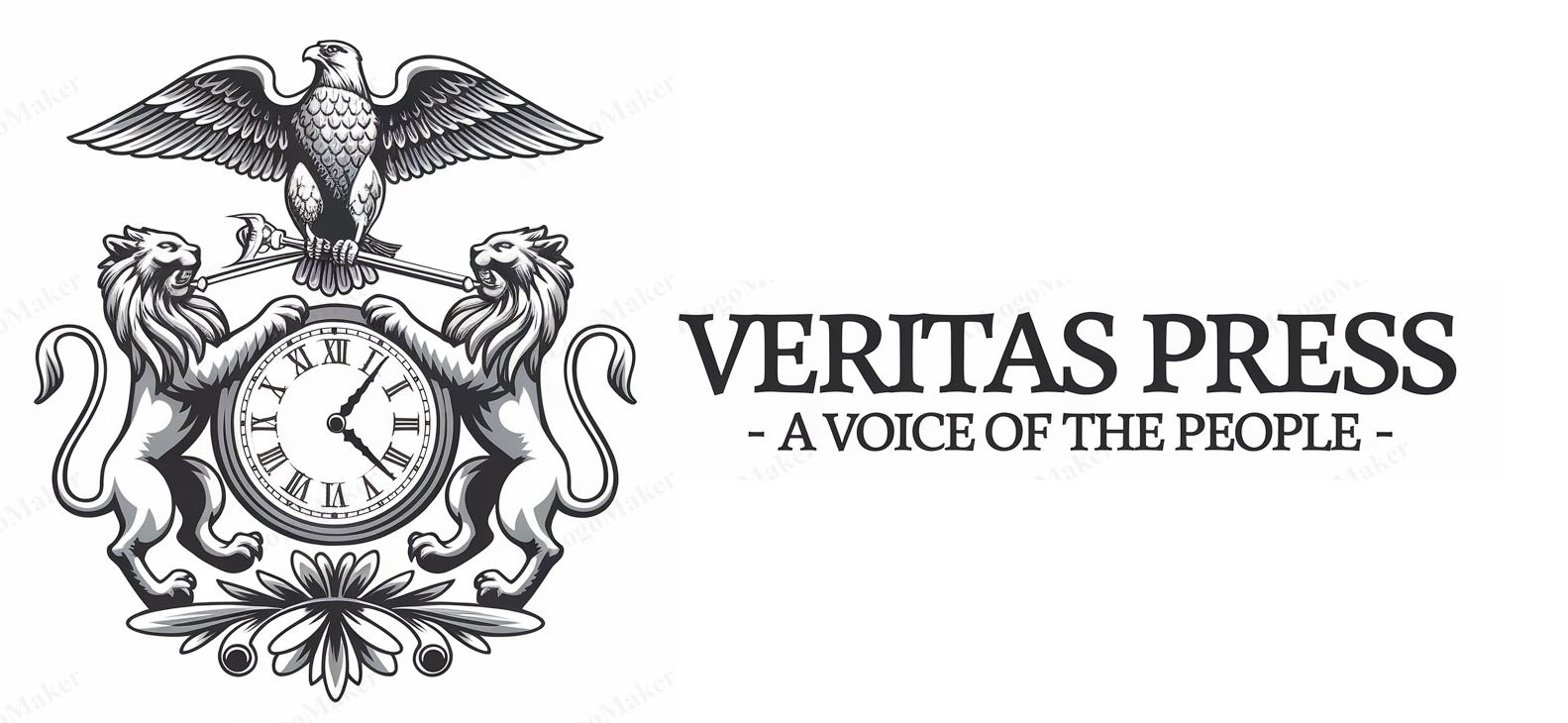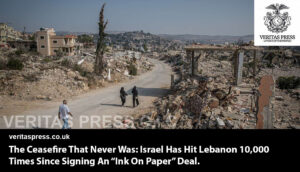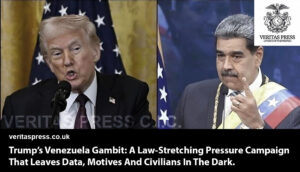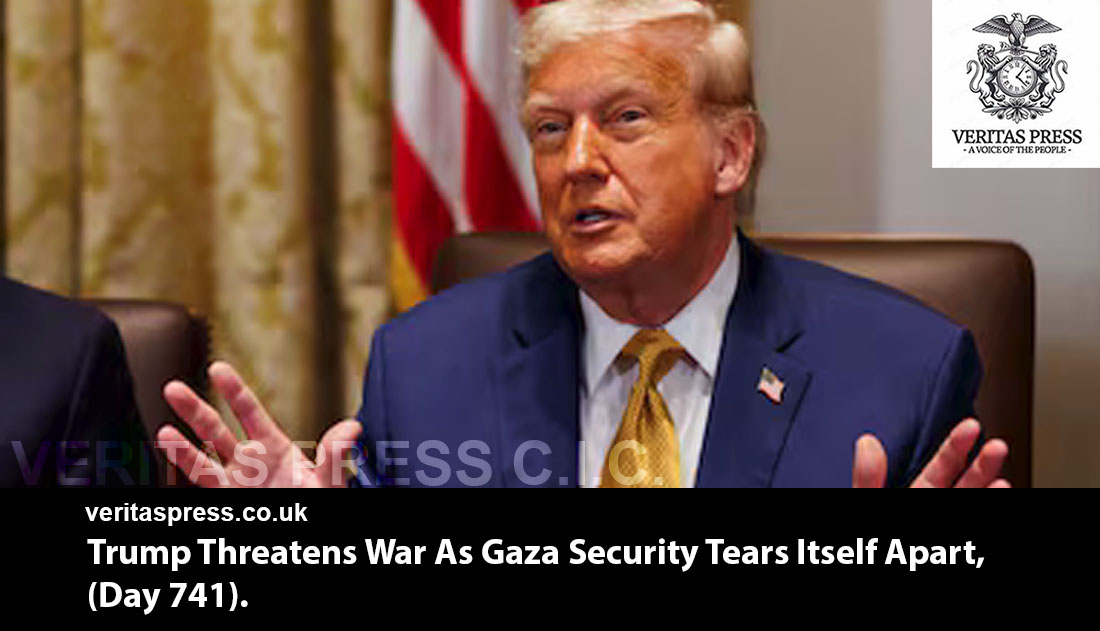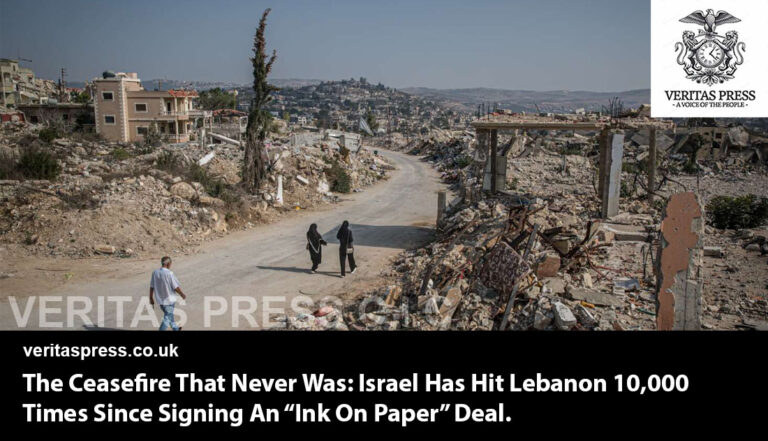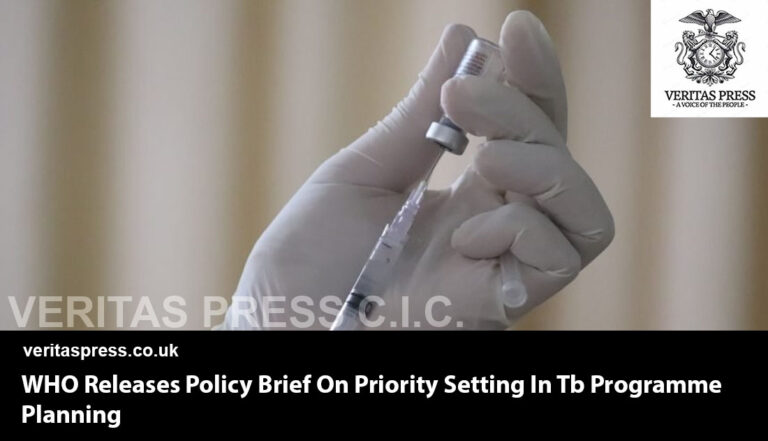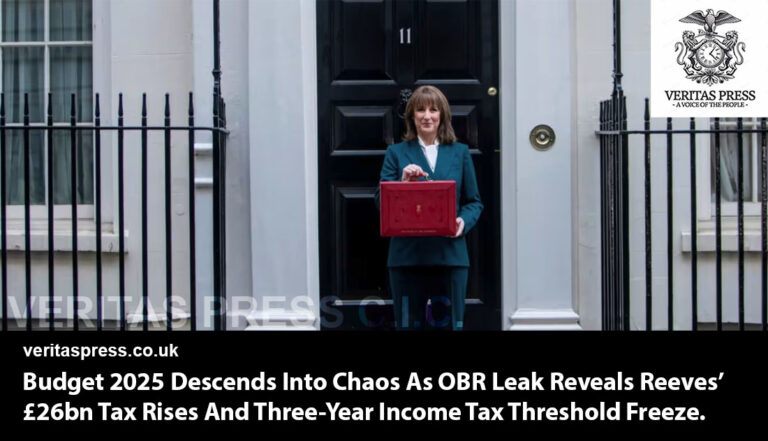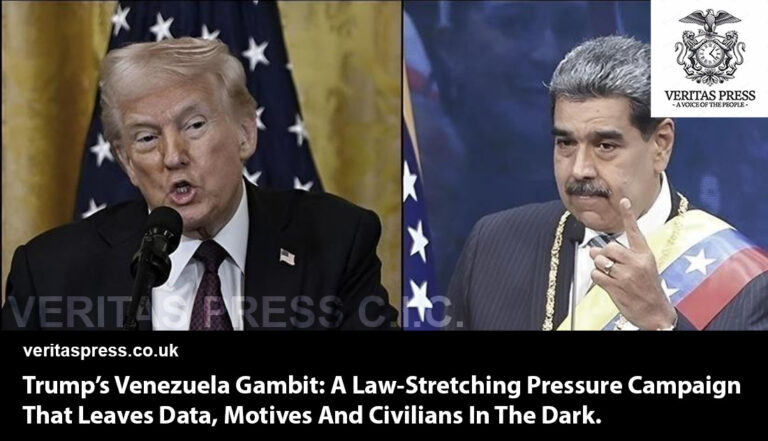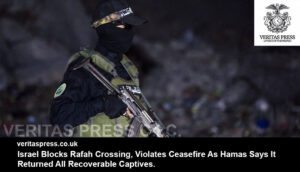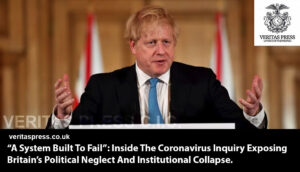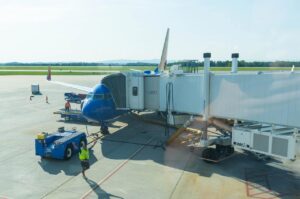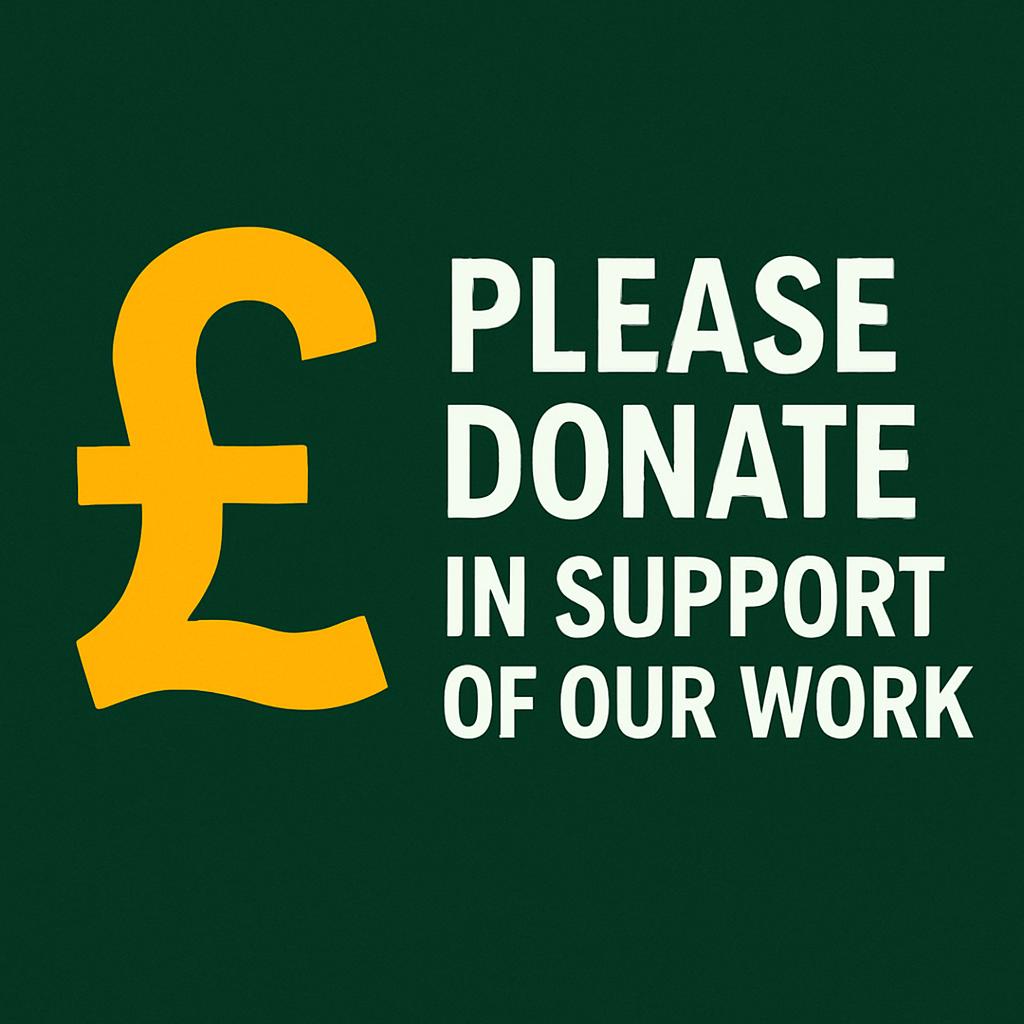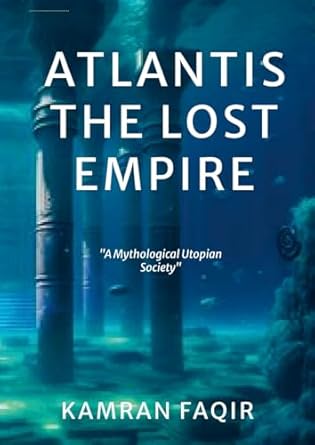Press Release: Veritas Press C.I.C.
Author: Kamran Faqir
Article Date Published: 16 Oct 2025 at 12:10 GMT
Category: USA | Politics | Trump Threatens War
Source(s): Veritas Press C.I.C. | Multi News Agencies

Business Ads
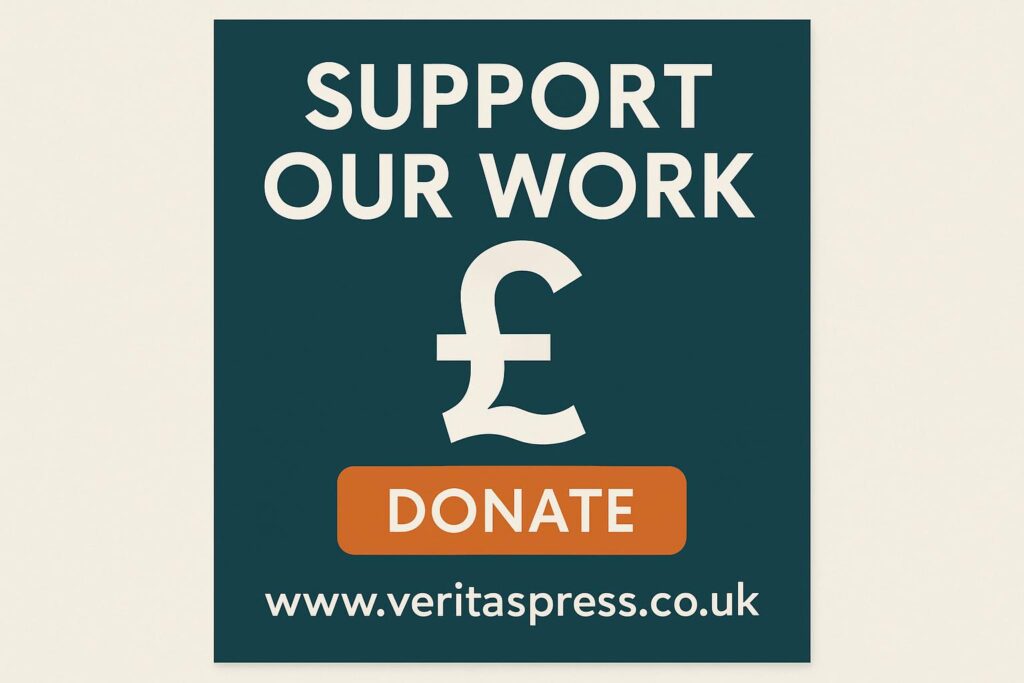

The ceasefire that many hoped would end two years of slaughter in Gaza has, in the space of days, exposed a brutal seam running through the territory’s ruins: a transition engineered from the outside that hands the keys of security, and with them the power to punish, detain and execute, to actors whose record on rights and accountability is deeply compromised. President Donald Trump’s repeated public ultimatum that “if [Hamas] don’t disarm, we will disarm them” has not just raised the spectre of renewed military assault; it has helped produce a vacuum in which summary justice, clan vendettas and a militarised policing of daily life are becoming normalised.
This piece examines who benefits from that vacuum, how U.S. policy is enabling a dangerous consolidation of force in Gaza, and what the price will be for civilians already buried under rubble and famine.
From Ceasefire To Crackdown: What We Actually Saw On The Ground.
Within days of the U.S.-brokered pause, hundreds of masked and uniformed gunmen reappeared on Gaza streets. They were not only former police, Reuters confirmed deployments of Qassam and internal security units, but also units carrying out public executions of men labelled “collaborators.” Reuters and other outlets documented at least three large, filmed street executions and dozens of killings in a coordinated wave that Gaza sources described as a targeted purge of rival militias, gangs and clans.
A Gaza-based activist summed up the atmosphere to Reuters: “The people of Gaza are lost, as if they are the walking dead, searching for a distant future.” Many displaced residents described relief at an end to the bombardment but fear at what would replace it. “Laughter has vanished and tears have run dry,” activist Mustafa Ibrahim told reporters.
Doctors and hospital officials have also provided stark testimony: forensic doctors in Gaza described bodies returned from the fighting as showing signs of execution, blindfolds, bound hands, single shots to the head, evidence that the violence shaping Gaza’s streets is not only opportunistic but systematically brutal. “Almost all of them had been blindfolded, and had been bound up, and they had gunshots between the eyes. Almost all of them had been executed,” Dr Ahmed al-Farra of Nasser hospital told The Guardian.
The U.S. Line: Inducement By Threat, Or Permission By Ambiguity?
President Trump’s rhetoric, that Hamas must disarm “or we will disarm them … perhaps violently,” is unambiguous in threat but ambiguous in means. He has publicly insisted that the U.S. will not send ground forces into Gaza even as Washington discusses an international stabilisation mission and plans to place around 200 personnel in support roles. Reuters reported U.S. advisers are in talks with regional states about participating in a stabilisation force; CENTCOM has urged Hamas to stop violence against civilians and “disarm without delay.”
That rhetorical mix, threats of military force, public praise for Hamas “policing” some areas temporarily, and plans for a multilateral stabilisation presence, produce a perverse incentive. On the one hand, the U.S. threatens a final military fix; on the other, it tacitly tolerates Hamas’s immediate use of force to “restore order.” The result: a fast, brutal reordering of Gaza’s coercive landscape under the cover of a fragile truce. Reuters captured the contradiction plainly: CENTCOM’s public exhortation to stand down came as Trump suggested Hamas had a temporary nod to police Gaza.
This ambiguity matters. When an external power publicly insists a militant actor must be removed but simultaneously allows it to act in the short term, that actor often uses the interval to consolidate power and eliminate rivals, exactly what we are seeing in Gaza.
Who Is Being Targeted, And Why The “Collaborator” Label Is Problematic:
Videos circulated online show summary executions of men forced to kneel and shot in public squares. Hamas officials and some local sources claimed the men were “collaborators” or members of criminal gangs and clan networks that had allegedly worked with Israeli forces or profited from looting. Reuters and The Guardian reported Hamas saying it was going after “gangs” and “collaborators” who threatened order.
But rights groups and the Palestinian Authority warn the label is being applied without due process. The Palestinian Authority condemned the executions as “heinous crimes,” while Human Rights Watch said the ceasefire and the U.S. plan cannot substitute for justice, and Amnesty International has documented that Palestinian armed groups have carried out summary killings and that Palestinian detention centres have a track record of torture and extrajudicial punishment. These are not isolated incidents; they echo earlier, documented abuses.
That is the core danger: in a shattered territory with collapsed judicial and investigative capacity, accusations of “collaboration” become a near-irrefutable pretext for murder. The victims are often people who had little means to defend themselves, alleged informants, petty criminals, former militia members who shifted allegiances, and civilians who happen to be caught in clan rivalries.
Aid, Rubble And The Politics Of Recovery: Why Bodies And Trucks Matter.
A central grievance now driving the threat of resumed fighting is the return of hostage remains and the flow of humanitarian aid. The Guardian and Reuters reported that Israel temporarily reduced truck entries and delayed opening Rafah after complaining Hamas had not handed over all the bodies it expected. Hamas said it had returned the bodies it could access and that further recovery required specialised equipment. These disputes over bodies have immediate, human consequences: Israel’s restrictions on aid risk deepening famine in an enclave already declared in parts to be in famine months ago.
For Gazans, food, fuel and medical supplies are the difference between survival and mass death. Yet the politics of recovery, who gets to shape it, under what conditions, and who polices the supply routes, are being decided by the same actors who have a record of weaponising aid and coercing populations. The U.S.-backed “international stabilisation” architecture being sketched out risks turning humanitarian corridors into instruments of political control unless strict, transparent safeguards are applied. Reuters reporting on the international force planning shows U.S. advisers are already discussing civilian safe zones and who will be excluded from reconstruction. Those decisions will determine not only who rebuilds Gaza, but who benefits from reconstruction contracts and who is permitted to remain.
Accountability Vacuum, Impunity On All Sides.
Two truths are now evident and interlocking:
- Israel’s two-year campaign devastated Gaza’s civilian infrastructure and produced tens of thousands of civilian deaths. Gaza health authorities report more than 67,000 killed and hundreds of thousands wounded, figures that are underrepresented, while contested in absolute terms, are staggeringly large and have been independently flagged as likely undercounts by academic and UN bodies. The human toll gives context to the rage and lawlessness now being policed, but it is no excuse for summary executions.
- Hamas, handed a near-monopoly of force in the short term, is using it with impunity. Its executions and beatings are being documented by international media, and rights bodies warn that without independent investigations and safeguards, these acts will entrench a regime of impunity. Human Rights Watch called the ceasefire “no substitute for action on aid and justice,” while Amnesty has catalogued abuses by both Israeli forces and Palestinian armed groups in earlier phases of the war.
Between them, external military power, an incoming international stabilisation architecture and local armed groups are engineering a post-war order without credible, independent oversight. That is a recipe for cycles of revenge and consolidation that will replicate the conditions which produced the original violence.
Eyewitness, Official And NGO Voices, What They Tell Us:
“We are lost, as if we are the walking dead.” — Mustafa Ibrahim, Gaza activist, describing civilians returning to rubble.
“We strongly urge Hamas to immediately suspend violence and shooting at innocent Palestinian civilians in Gaza.” — CENTCOM Commander Brad Cooper.
“If they don’t disarm, we will disarm them, and it will happen quickly and perhaps violently.” — U.S. President Donald Trump.
“Almost all of them had been blindfolded, and had been bound up, and they had gunshots between the eyes. Almost all of them had been executed.” — Dr Ahmed al-Farra, Nasser hospital (on bodies returned showing signs of execution).
“The U.S. Comprehensive Plan is no substitute for urgent action to protect civilians and support justice after two years of grave abuses.” — Human Rights Watch summary critique.
These voices point to a common conclusion: civilians bear the costs of geopolitical fixes and the collapse of legal norms. The photographs and video from Gaza are not only evidence of suffering; they are primary evidence of how quickly a security transition can become a security catastrophe when unmoored from accountability.
What A Just, Durable Way Forward Would Require (Not Exhaustive):
- Independent investigations — immediate, impartial probes into summary executions, detention abuses and alleged war crimes by all sides, with international forensic capacity to examine returned bodies and sites. No credible reconstruction can begin without truth. (Human rights groups have repeatedly called for this.)
- Guaranteed humanitarian access — unconditional, sustained opening of crossings (including Rafah) and clear protections for aid convoys; depoliticise aid distribution and subject it to independent monitoring. The current practice, linking aid flows to political disputes over bodies or security, is a morally perverse lever.
- Accountable security sector reform — any international stabilisation force must operate under a clear mandate that prioritises civilian protection, prohibits transfer of detainees to abusive hands, and insists on vetting and oversight of any local police trained or supported by foreign actors. Vague commitments to “stabilisation” are not enough.
- Civilian-centred reconstruction — contracts, reconstruction priorities and residency rights must be transparent and driven by the needs of displaced people, not by geopolitics or patronage. Otherwise, rebuilding will rebuild inequality and grievance.
Conclusion: Why This Matters Beyond Gaza.
The escalating crisis in Gaza and the West Bank has entered a stage where political rhetoric and military logic have entirely consumed humanitarian considerations. As Trump’s threats of war reverberate across the region, Palestinians remain trapped between Israeli bombardment, internal crackdowns, and the international community’s paralysis. “Gaza has become a laboratory of human suffering, an open-air prison that’s now being starved, bombed, and surveilled into submission,” said a senior UN relief official speaking anonymously to Middle East Eye.
Human rights groups warn that the ongoing campaign against alleged “collaborators,” often carried out without due process, mirrors the same systems of impunity Israel has institutionalised under occupation. “Both sides are enforcing control through fear,” observed Omar Shakir, Israel and Palestine Director at Human Rights Watch, noting that “Palestinians are being crushed not just by siege and famine, but by repression that silences dissent.”
Meanwhile, Israel’s continuing raids, paired with Trump’s bellicose rhetoric, mark what analysts describe as “the militarisation of diplomacy.” Former Israeli security official Amos Gilad told Haaretz that “Washington’s green light to Tel Aviv risks dragging the entire Middle East into a confrontation far beyond Gaza.” Eyewitnesses in Rafah and Khan Younis described scenes of devastation and panic as so-called “security operations” turned into mass arrests and targeted killings. “They’re calling it security, but it feels like purging,” said Mariam al-Qudra, a displaced teacher sheltering in a UN school. “We fear not only the planes above us but those who come to take people at night.”
The deeper truth emerging from Gaza is not merely one of military conflict, but of systematic dehumanisation, a process that international institutions appear powerless or unwilling to halt. As the International Criminal Court drags its feet and Western capitals continue to arm Israel, the siege’s human toll grows daily. “If the world allows Gaza to be erased under the pretext of ‘security’ or ‘terrorism,’ it will signal the end of the international legal order itself,” said Palestinian legal scholar Rania Muhareb.
With all the theatrics on display, it is evident that the U.S. and Israel have no intention of honouring peace. Just hours after the ceasefire was announced, Israel violated the agreement, launching new strikes and raids that shattered what little calm remained. Since then, it has continued to breach the ceasefire terms with impunity. In response, Hamas’s armed resistance has retaliated, even as it confronts U.S.-backed proxy gangs and internal collaborators. The cycle of violence is no accident; it is being maintained by design, calibrated to exhaust Palestinian resistance while preserving Israel’s strategic dominance.
Trump’s alleged “peace force,” reportedly being deployed in the region’s “relevant surroundings,” further underscores that this is not reconstruction but reoccupation under another name. Analysts and Palestinian officials alike warn that the presence of such a foreign “stabilisation force,” drawn from U.S.-aligned militaries, signals the imposition of an external security regime to oversee Gaza’s political and economic future. “This is not peacekeeping,” said political analyst Yousef Munayyer. “It’s an occupation under a softer flag, a way to control Gaza’s reconstruction while keeping Palestinians permanently dependent on foreign supervision.” What is being marketed as recovery and rebuilding is, in reality, the architecture of domination, the transformation of Gaza into a securitised protectorate managed through Western capital and compliant local elites.
The choices made now, who gets to police, who gets to judge, who gets to rebuild, will determine whether Gaza becomes a coerced, securitised protectorate or a society capable of political life. When external powers threaten “disarmament by force” while tolerating immediate, brutal consolidations, they calibrate a post-war reality that will produce more cycles of violence, not fewer. The images from Gaza’s streets, people killed in public, rubble where neighbourhoods once stood, aid trucks stopped at crossings, are the consequences of a conflict that has not ended in justice.
President Trump’s words are not neutral; they are an accelerant to a dynamic that privileges force over law. By invoking war while ignoring the siege’s civilian cost, Washington entrenches the very instability it claims to deter. If the international community truly cares about civilian protection, it must insist that those who hold power in Gaza, and those who enable them, be held to human-rights obligations now, not after they have cemented control over a population too broken to resist.
Ultimately, Gaza stands as both a wound and a warning: the test of whether the world’s commitment to law, dignity, and accountability is anything more than performance. As one activist told Al Jazeera, “Gaza has become the mirror of global hypocrisy, and the frontline of humanity’s conscience.”
